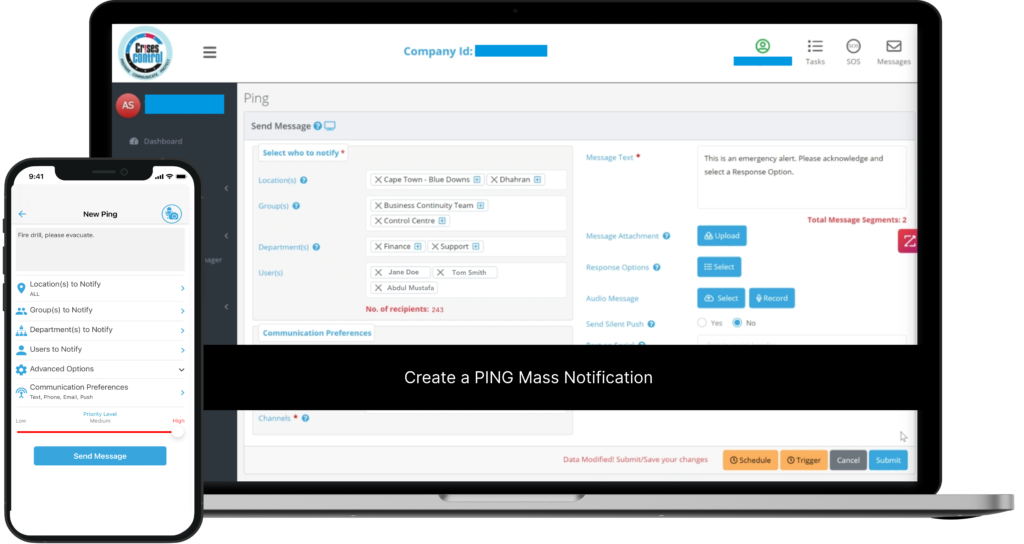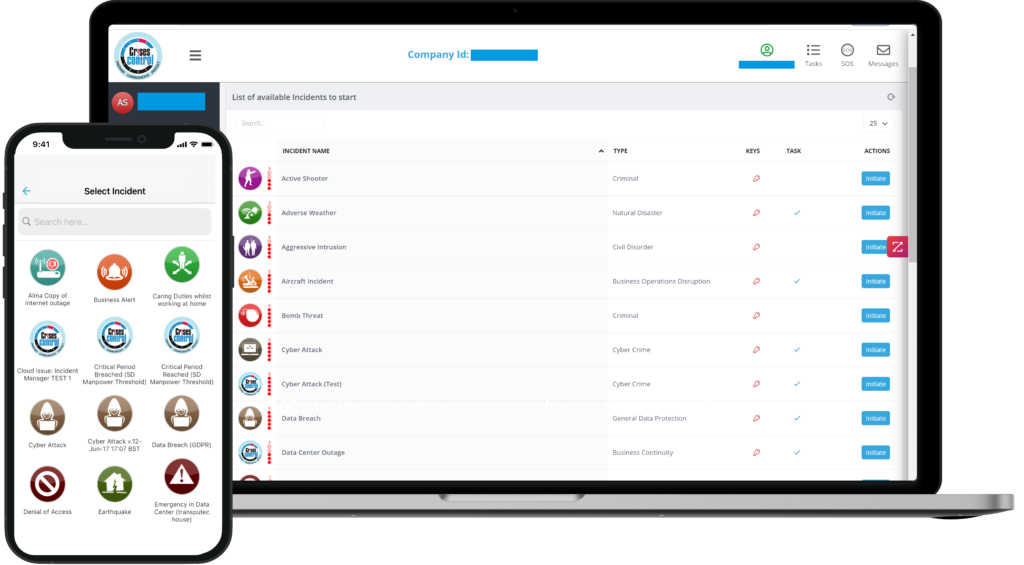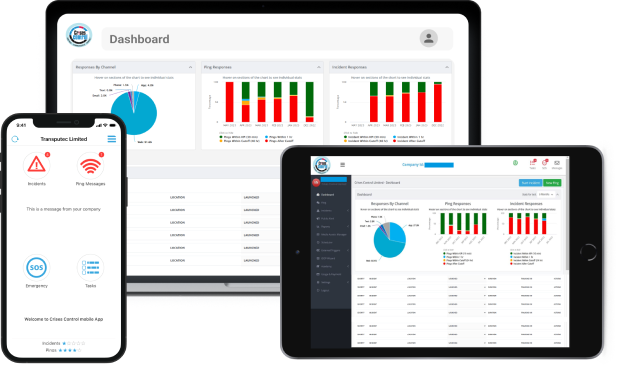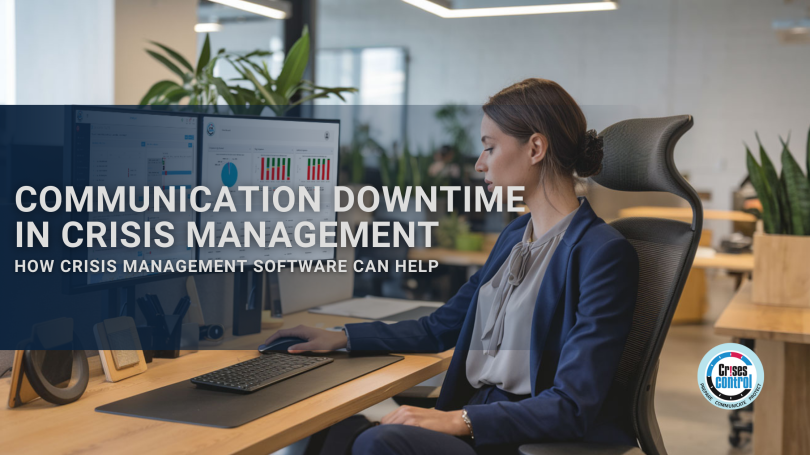Written by Anneri Fourie | Marketing Executive
Effective communication is the backbone of any crisis management strategy. When communication systems fail during a crisis, the impact can extend far beyond the immediate disruption. It can lead to costly delays, poor decision-making, and even permanent damage to a company’s reputation. In this blog, we’ll explore how communication downtime directly affects crisis management, the financial implications, and how Crisis Management Software can help reduce these risks.
The Impact of Communication Downtime on Crisis Management
Communication downtime refers to any delay, failure, or disruption in the flow of critical information during an emergency. In crisis management, these breakdowns can quickly multiply the severity of a situation, causing more harm than good. Let’s look at some key areas where communication downtime has a significant impact:
1. Delayed Emergency Responses
When communication systems fail, the first line of defence – rapid response – is compromised. Decision-makers can’t get the information they need, and crucial steps are delayed. Whether it’s a fire, a cyber attack, or an operational failure, quick action is vital. A delay, even by a few minutes, can escalate the incident, causing greater damage and potentially putting lives at risk.
In industries like healthcare or aviation, delays in communication can lead to catastrophic outcomes. A breakdown in communication can mean slower evacuations, delayed medical interventions, and missed opportunities for damage control.
2. Financial Losses
The cost of communication downtime isn’t just about lost hours or disrupted operations – the financial implications can be massive. Let’s break down some of the financial impacts:
- Revenue Loss: Downtime causes businesses to halt their operations. Whether it’s a retail company unable to process orders or a factory shutting down production lines, every minute of inaction means lost sales.
- Fines and Penalties: In regulated industries, failure to communicate during a crisis can result in severe fines. For example, in sectors like finance or healthcare, failing to meet regulatory requirements during a crisis can lead to costly penalties.
- Increased Recovery Costs: In addition to lost revenue, recovery becomes more expensive when communication systems fail. Businesses may need to invest in additional resources, hire external consultants, or pay overtime to employees to make up for lost time.
3. Reputational Damage
As we all know, a brand’s reputation is everything. During a crisis, stakeholders expect timely, transparent communication. When companies fail to deliver this, they risk losing customer trust, damaging their brand image, and even facing negative media coverage.
Effective communication isn’t just about delivering information – it’s about showing that a company is in control, has a plan, and is actively addressing the crisis. If a company fails in this area, customers, investors, and employees may jump ship. The reputational damage could take years to repair, if it can be repaired at all.
4. Threat to Business Continuity
Business continuity is the ability to continue operations during and after a crisis. Without reliable communication, maintaining this continuity becomes nearly impossible. Teams can’t coordinate, response plans can’t be executed, and the crisis becomes harder to manage. In such cases, operational paralysis sets in, leaving the company vulnerable to prolonged downtime, financial loss, and more significant damage to its operations.
A Cost Analysis: The True Price of Communication Downtime
To better understand how communication downtime affects businesses, let’s break down the costs into three primary categories:
1. Direct Costs
- Revenue Loss: Unplanned downtime means the business can’t operate at full capacity. Whether it’s manufacturing delays, service disruptions, or delayed product deliveries, the impact on revenue is immediate and substantial.
- Fines and Penalties: Many industries are bound by strict regulations that require businesses to respond to crises quickly and efficiently. A failure to do so can result in substantial fines, especially in industries like finance, healthcare, and energy.
2. Indirect Costs
- Reputational Damage: Even if a business manages to recover quickly, the damage to its reputation can linger. Customers, partners, and investors may be reluctant to trust a company that has failed to communicate effectively during a crisis.
- Employee Morale: In the absence of clear communication, employees may become confused, stressed, and disengaged. This can lead to low morale, decreased productivity, and even higher turnover in the aftermath of the crisis.
3. Opportunity Costs
- Missed Business Opportunities: During a crisis, delayed responses can result in missed opportunities. Whether it’s a business partnership, a key contract, or a new product launch, missed opportunities during a crisis are hard to recover from.
- Competitive Disadvantage: Competitors that are better prepared to handle crises will have the edge. They’ll continue operating smoothly while your business struggles to recover. Over time, this can cause long-term damage to market position and profitability.
How Crisis Management Software Minimises Downtime Costs
While the costs of communication downtime can be staggering, the good news is that these risks can be mitigated with the right tools. Crisis Management Software is designed to help businesses communicate quickly and effectively during an emergency, ensuring minimal disruption and fast recovery. Crisis Management Software can help reduce the costs associated with communication downtime by offering key features such as:
1. Real-Time Alerts and Notifications
An Emergency Notification System is one of the key features to look for in Crisis Management Software. This system allows businesses to instantly send alerts to employees, customers, and stakeholders across multiple channels (SMS, email, push notifications, phone calls and web alerts). Real-time communication ensures that everyone stays informed and can take the necessary actions without delay.
2. Cloud-Based Infrastructure
A cloud-based platform ensures high availability and scalability. Whether your company faces a power outage, system failure, or other technical issue, a cloud-based solution guarantees that you can continue to communicate effectively even if your on-premises infrastructure goes down.
3. Incident Management
Crisis Management Software often includes Incident Management features, which allow businesses to automate crisis response workflows. This helps ensure that critical actions are taken quickly and that all team members are on the same page. By assigning tasks automatically and providing real-time updates, the software helps eliminate delays and confusion during a crisis.
4. Multichannel Communication
Communication channels are critical in a crisis. The ability to send alerts via SMS, email, phone calls, web alerts and mobile apps ensures that your message reaches everyone, no matter where they are. With multichannel communication, businesses can ensure no one is left out, even if one communication method fails.
How Crises Control Can Help
Crises Control is designed to address all the challenges mentioned above, helping businesses reduce the impact of communication downtime during a crisis. Here’s how Crises Control can transform your approach to crisis management:
1. Ping Mass Notification System
With the Ping Mass Notification System, Crises Control helps businesses instantly broadcast critical alerts across multiple communication channels, ensuring that you can reach everyone in under one minute, and reduce the time to engage stakeholders by up to 96%. Whether it’s a natural disaster, system outage, or security threat, your team and stakeholders will always stay informed.
Interested in our Ping Mass Notification System?
Efficiently alert everyone in seconds at scale with our Mass Notification System – PING, get the message out fast and ensure rapid response and recovery.

2. Incident Manager Module
Crises Control’s Incident Manager module automates your crisis response plans, assigns tasks, and provides real-time updates, leading to a 20% improvement in incident resolution times. This ensures that your team acts quickly, efficiently, and without delay, reducing the cost of downtime and improving overall crisis management.
3. Task Manager
The Task Manager feature allows you to delegate and track tasks in real-time, helping you stay in control of the incident response, even when the situation feels chaotic. With Task Manager, you can manage numerous tasks involved in incident management, track task progress, and check off completed tasks as you move closer to incident resolution. Benefits of the Crises Control Task Manager include managing incidents in one place, seeing customised plans for each type of incident, tracking tasks from initiation to completion, and creating checklists to ensure tasks are completed in the right order. This ensures nothing is overlooked and all necessary steps are carried out promptly, improving overall incident management efficiency.
4. Cloud-Based Hosting
Crises Control operates on its own cloud infrastructure with global cloud locations in the United Kingdom (UK), Europe, the Middle East (GCC Countries), and North America (USA and Canada), ensuring that your crisis management platform is always available, even during system failures or outages. Additionally, we offer local hosting in the Kingdom of Saudi Arabia, providing even greater reliability and data sovereignty for businesses in the region. This means you won’t have to worry about communication breakdowns, no matter what happens.
5. SOS Panic Button
Employees can send instant distress signals through the SOS Panic Button feature, enhancing workplace safety and ensuring swift responses to emergencies. Some of the key features of the Panic Button APP include GPS tracking, real-time updates, and automatic notifications to the emergency response team. Additionally, the Panic Button APP is easy to use and can be customised to meet the specific needs of your organisation. The app is also secure and reliable, with SSL encryption for all communications and data, ensuring that all alerts and messages are kept confidential and secure at all times.
Key safety features include Track Me, which provides support when an employee’s personal safety could be at risk, and Silent Push Notifications, a discreet feature that ensures alerts are sent silently, preventing an alert noise from escalating the situation.
6. Comprehensive Reporting and Audit
After a crisis, Crises Control provides detailed reports that allow businesses to review the effectiveness of their communication strategy. This post-crisis analysis helps identify gaps and refine response plans for future incidents. The incident reporting and audit dashboard and control centre provide all the data you need during an incident to maintain control and make important decisions. This data will help you assess how plans performed and inform improvements by your in-house teams. You can store plans and reports securely in the Crises Control platform, ensuring that they are easily accessible when you need them most.

Interested in our Incident Management Software?
Customise your Crisis Incident Management Software to meet your specific needs with our flexible tools & stay connected and informed during the crisis and incident management process
Case Study: Beale & Co – Enhancing Crisis Communication with Crises Control
Beale & Co, a law firm with over 180 years of experience in the construction, engineering, and insurance sectors, needed a more efficient way to communicate with staff during emergencies. Previously relying on desktop notifications, they sought a solution that would allow mobile-based communication and provide acknowledgment functions to ensure staff safety.
The firm adopted Crises Control, which enabled them to send real-time incident notifications and track staff responses across various locations, including the UK, Ireland, and the UAE. The integration of Crises Control into their Business Continuity Plan proved seamless, especially during a recent incident, ensuring effective communication and business continuity.
“Crises Control provided the precise solution we were seeking, enabling us to swiftly communicate with our staff in the UK, Ireland, and UAE during critical situations.“
– Victoria Hinds, Head of Facilities, Beale & Co
Read the Full Case Study
Key Points to Remember
- Delayed Emergency Responses: Communication breakdowns can delay rapid responses, leading to escalated crises, financial losses, and reputational damage.
- Financial Losses: Downtime results in lost revenue, fines, penalties, and increased recovery costs.
- Reputational Damage: Failure to communicate effectively during a crisis can severely damage a company’s brand image and stakeholder trust.
- Threat to Business Continuity: Without reliable communication, business continuity is jeopardised, leading to operational paralysis and further complications.
How Crisis Management Software Minimises Downtime Costs:
Crisis Management Software helps mitigate downtime risks by enabling real-time alerts, cloud-based infrastructure, incident management, and multichannel communication.
Crises Control’s Key Features:
- Ping Mass Notification System: Reach everyone in under one minute and reduce stakeholder engagement time by 96%.
- Incident Manager Module: Automates response plans and improves incident resolution times by 20%.
- Task Manager: Stay in control with task delegation, tracking, and real-time updates during a crisis.
- Cloud-Based Hosting: Global cloud locations and local hosting in Saudi Arabia ensure uninterrupted service.
- SOS Panic Button: Secure, easy-to-use panic button app with GPS tracking and silent notifications for workplace safety.
- Comprehensive Reporting and Audit: Post-crisis analysis and secure reporting for continuous improvement.
These features work together to ensure your business can respond quickly, maintain control, and minimise the costs associated with crisis situations.
Conclusion: Don’t Let Communication Downtime Cost You
The cost of communication downtime during a crisis is substantial, but it doesn’t have to be inevitable. With the right tools in place, businesses can respond quickly, reduce the financial impact, and protect their reputation. Crises Control’s Crisis Management Software ensures that your company can maintain effective communication, even in the most challenging situations.
Ready to take control of your crisis management strategy? Contact us today to book a free, personalised demo and see how Crises Control can help your business stay resilient in the face of any crisis.
Request a FREE Demo

